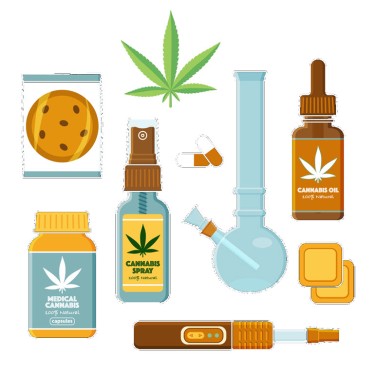Cannabis News
No Bankruptcy Protection, Just Receivership for Cannabis Companies
Published
2 years agoon
By
admin

Oregon’s leading cannabis company, Chalice, is grappling with a severe financial crisis that has prompted significant measures. According to the ‘Willamette Week’, the company, burdened by debts exceeding $35 million, has filed a request with the Multnomah County court to place five of its subsidiary companies under the control of a receiver. Notably, Chalice operates 15 dispensaries across the state.
This recent court action sheds light on the dire situation that Oregon’s third-largest dispensary chain faces. Small cannabis businesses have accused Chalice of non-payment, while Chalice claims substantial amounts are owed to them by their wholesale partners.
Chalice attributes its cash problems to an oversupply of cannabis in the market and the unexpected delay in federal deregulation, as stated by Oregon Live. Consequently, this predicament has led landlords to threaten Chalice with property seizure due to unpaid rent. Chalice Brands, the parent company based in Toronto, is actively seeking a buyer for all its assets.
To further address their financial challenges and avoid legal action from creditors, Chalice has sought protection from a Canadian court to reorganize their assets. The majority of the borrowed funds are owed to institutional lenders in Canada and the U.S.
The court filing is notable as it involves a vertically integrated cannabis company operating within Oregon, with the plaintiff and defendants being part of the same organization. Chalice’s CEO emphasizes that the lawsuit is not adversarial but necessary to secure a receiver for their assets. Despite being a Canadian company, all of Chalice’s assets are located in the United States.
Trading of Chalice’s stock in Canada has been suspended since May 2022 due to their failure to file financial reports for 2021 and 2022.
Chalice is hopeful that the receivership process will provide them with time to explore various options, including selling the company or seeking investments to alleviate their financial situation.
What Is Receivership About?
By appointing a receiver to oversee a company’s assets and operations, receivership is a legal procedure created to safeguard the interests of creditors and stakeholders. This implies that in the instance of Chalice Farms, a court-appointed receiver will be in charge of monitoring the business’ operations and guaranteeing its financial stability and compliance with the law.
The receiver is given control over a number of areas of the business, including its resources, finances, and employees. They are qualified for this position because to their experience managing distressed firms, and the court has given them particular rights and obligations. The receiver is required to submit regular reports to the court detailing the company’s financial situation and advancement throughout the receivership process. Their main goal is to steer the business through this difficult time while protecting the interests of stakeholders and creditors.
Reasons Behind Chalice Farms’ Decision
A combination of the company’s financial woes, commercial difficulties, and regulatory problems led Chalice Farms to decide to seek receivership.
The considerable financial difficulties Chalice Farms has faced are one of the main elements influencing this choice. The business has struggled to sustain profitability and meet its financial obligations due to rising indebtedness and liquidity problems.
Additionally, Chalice Farms is facing stiffer competition in the Oregon marijuana industry. Due to increased pricing pressures brought on by the market’s large number of participants, Chalice Farms’ profitability has decreased, making it more challenging to achieve long-term financial success.
The regulatory context in which the cannabis sector operates is very complicated. It can be difficult and time-consuming for Chalice Farms to negotiate the changing legislation and licensing requirements. The corporation’s financial health has been further hampered by non-compliance with these regulations and the resulting penalties.
Chalice Farms has decided that applying for receivership is the best course of action to manage its financial difficulties and safeguard the interests of its creditors in light of the current situation. The company hopes to reestablish stability and start along a path of recovery by going into receivership. This would enable it to address its financial issues and open the door for potential future growth.
The Impacts of Seeking Receivership
Chalice Farms’ decision to pursue receivership arises from a combination of factors that have collectively influenced their choice. Firstly, the fiercely competitive nature of the cannabis industry in Oregon has placed immense pressure on businesses to differentiate themselves and maintain profitability. The market saturation and the presence of numerous competitors have presented challenges for Chalice Farms in attracting and retaining customers.
Moreover, the specific regulatory and legal challenges within the cannabis industry have likely played a significant role in their decision. Navigating the complex and costly state and local regulations is crucial, as non-compliance can lead to penalties and adverse consequences. Chalice Farms may have encountered difficulties in ensuring compliance, further straining their financial position.
Additionally, external economic factors have likely contributed to their choice. Changes in consumer preferences, shifts in buying patterns, or fluctuations in the overall economy can have adverse effects on revenue and profitability. Like any business, these external forces may have impacted Chalice Farms.
The decision to seek receivership holds extensive implications for Chalice Farms’ operations. Receivership involves appointing a third-party receiver who assumes control over the company’s assets and operations. The primary objective is to safeguard the interests of creditors, with the receiver typically appointed by a court to oversee the company’s affairs during this period.
As Chalice Farms enters receivership, significant changes are anticipated in their day-to-day operations. The receiver may implement cost-cutting measures, undertake a business restructuring, or explore potential sale opportunities to address financial challenges. Operational adjustments could involve streamlining processes, reducing staff, renegotiating contracts with suppliers, or making strategic decisions aimed at stabilizing the company’s financial position.
Furthermore, choosing receivership can impact Chalice Farms’ relationships with various stakeholders, including employees, suppliers, and customers. Employees may face uncertainties regarding job security and potential layoffs, while suppliers and business partners may experience disruptions in contracts or payment terms. Customers may also be affected as operations or reduced product availability changes could influence their purchasing experience.
Bottom Line
Chalice Farms’ decision to seek receivership results from the convergence of financial difficulties, market challenges, and regulatory issues. The company’s mounting debt, intense competition in the Oregon cannabis industry, and complexities of regulatory compliance have taken a toll on its financial health. Seeking receivership is a strategic move to address these challenges and protect the interests of creditors. While the receivership process will bring operational changes and potentially impact stakeholders, Chalice Farms aims to stabilize its financial position and explore options for future growth. The case of Chalice Farms serves as a reminder of the ongoing dynamics and hurdles faced by businesses operating in the cannabis industry, emphasizing the importance of financial resilience and adaptability in this rapidly evolving sector.
CANNABIS BANKRUPTCY, READ ON…
Cannabis News
America’s Constitutional Conundrum: Guns and Ganja
Published
14 hours agoon
January 21, 2025By
admin

Of Guns and Ganja: America’s Constitutional Conundrum
If there’s one thing America is famous for, it’s guns – and lots of ’em! In the land of the free and home of the brave, firearms aren’t just a right, they’re practically a national pastime. With over 400 million firearms floating around a nation of 330 million people, it’s safe to say that guns are as American as apple pie and baseball.
But you know what else Americans love? Drugs. The US remains the world’s largest drug market, with an particularly passionate affair with cannabis. Mary Jane has come a long way since the “Just Say No” propaganda of the D.A.R.E. days. Now, millions of Americans legally light up in their home states, transforming from “criminals” to “consumers” faster than you can say “tax revenue.”
Here’s where things get sticky though. Despite the Biden administration’s vague promises of reform, cannabis remains stubbornly classified as a Schedule I substance at the federal level. This creates a peculiar predicament for freedom-loving Americans who appreciate both their Second Amendment rights and their evening toke.
You see, there’s this obscure interpretation of federal law that says if you consume cannabis – even legally in your state – you’re technically not allowed to own firearms. Let that sink in for a moment: in a country with more guns than people, where cannabis is legally sold in most states, you’re forced to choose between your constitutional right to bear arms and your state-sanctioned right to consume a plant.
As you might imagine, telling Americans they can’t have their guns AND their ganja isn’t exactly going over well. It’s a uniquely American saga that pits state rights against federal law, personal freedom against bureaucratic overreach, and common sense against, well… whatever you’d call this situation.
Let’s dive into this bizarre legal battleground where constitutional rights and cannabis collide.
As America’s cannabis landscape evolves, we’re witnessing a fascinating legal tug-of-war between state sovereignty and federal authority. The latest battleground? The constitutional rights of cannabis consumers to bear arms.
In a groundbreaking decision, the U.S. Court of Appeals for the Fifth Circuit recently reaffirmed that banning occasional marijuana users from owning firearms is unconstitutional. The case, known as U.S. v. Daniels, centers around a man who was sentenced to four years in prison after police found trace amounts of cannabis and firearms during a routine traffic stop. Talk about wrong place, wrong time!
The federal government, particularly under the Biden administration, has been performing some impressive mental gymnastics to justify their position. Their argument? Cannabis users with guns “endanger public safety,” “pose a greater risk of suicide,” and are more likely to commit crimes “to fund their drug habit.” They’ve even argued that cannabis consumers are “unlikely to store their weapons properly.” I guess they never met my ex-military uncle who meticulously organizes his gun safe while enjoying his evening edible.
But here’s where it gets really interesting. The Department of Justice claims the restriction is perfectly constitutional because it aligns with the nation’s history of disarming “dangerous” individuals. They’re essentially putting cannabis users in the same category as folks with domestic violence restraining orders. As someone who’s spent considerable time around both cannabis users and domestic abusers (professionally, of course), I can tell you there’s a slight difference in temperament.
The courts, however, aren’t buying it. As the Fifth Circuit pointed out, the government failed to prove that Daniels was “presently or even regularly intoxicated at the time of arrest.” They noted that even if the government had proven frequent intoxication, they offered “no Founding-era law or practice of disarming ordinary citizens ‘even if their intoxication was routine.'”
The ruling doesn’t completely invalidate the federal statute (known as § 922(g)(3)), but it does expose its shaky constitutional foundation. As the court stated, “This is not a windfall for defendants charged under § 922(g)(3),” but rather a recognition that the government’s enforcement approach is fundamentally flawed.
Meanwhile, the National Rifle Association (NRA) – not exactly known for their progressive stance on substances – acknowledges the absurdity of the situation. They point out that “marijuana use is no longer limited to the domain of indigenous religious customs or youth-oriented counterculture and now includes a wide variety of people who use it for medicinal or recreational reasons.” When even the NRA is suggesting your gun control measure might be a bit extreme, you know something’s amiss.
The result of all this legal wrangling? A patchwork of confusion where state-legal cannabis users must choose between their Second Amendment rights and their medicine or recreational preference. It’s a prime example of how federal prohibition creates more problems than it solves, forcing otherwise law-abiding citizens to become unwitting criminals simply for exercising multiple legal rights simultaneously.
Welcome to America, folks, where you can have your guns or your ganja, but apparently not both – at least until the courts finish sorting out this constitutional cannabis conundrum.
Let me be blunt – we’re caught in a classic American political pretzel. The Biden administration dangles the carrot of rescheduling cannabis to Schedule III, making vague promises that sound good on the campaign trail but do little to address the fundamental issues plaguing cannabis consumers, including their right to bear arms.
While some celebrate these baby steps toward reform, I’ve been around this block enough times to know that rescheduling is like putting a Band-Aid on a bullet wound. It might stop some bleeding, but it doesn’t address the underlying trauma. The gun rights issue is just one of many complications that arise from cannabis’s continued inclusion in the Controlled Substances Act (CSA).
Here’s the uncomfortable truth: there’s only one real solution, and it runs straight through the halls of Congress. The same body that created this mess with the CSA in 1971 is the only one with the power to truly fix it. Congress needs to completely remove cannabis from the CSA – not reschedule it, not modify its status, but fully deschedule it.
Think about it. Rescheduling to Schedule III would still leave cannabis in a weird legal limbo. Sure, it might make research easier and give Big Pharma more room to play, but what about the millions of Americans who use cannabis medicinally or recreationally in their state-legal markets? They’d still be federal criminals, still banned from purchasing firearms, still caught in the crossfire between state and federal law.
The only path forward is complete removal from the CSA, coupled with a federal framework that respects state markets while establishing basic national standards. This would resolve the gun rights issue overnight – no more choosing between your Second Amendment rights and your medicine or recreational preference.
Would I love to see Congress completely overhaul the CSA? Absolutely. The entire scheduling system is based on outdated science and political theater rather than actual harm reduction principles. But let’s be realistic – that’s about as likely as finding bipartisan agreement on… well, anything these days.
Instead, we need to focus on what’s achievable: complete cannabis descheduling. This isn’t just about guns and ganja – it’s about fixing a broken system that’s created countless legal paradoxes and unnecessary criminal penalties. It’s about acknowledging that the emperor has no clothes, that cannabis prohibition has failed, and that it’s time to move forward with a sensible federal policy.
Until Congress acts, we’ll continue to see these legal battles play out in courts across the country, watching judges try to reconcile constitutional rights with outdated federal drug laws. It’s a waste of judicial resources, taxpayer money, and most importantly, it’s a waste of Americans’ time and freedom.
The solution is clear. The only question is: how many more Americans need to get caught in this legal crossfire before Congress finally does its job?
Inspiration:
https://www.marijuanamoment.net/federal-court-reaffirms-that-ban-
on-gun-ownership-for-people-who-occasionally-use-marijuana-is-unconstitutional/
https://www.marijuanamoment.net/nra-says-federal-ban-on-
marijuana-amid-state-level-legalization-has-created-confusing-legal-landscape-for-gun-owners/
CANNABIS AND GUN RIGHTS, READ ON…
Cannabis News
MLK Day 2025: Cannabis and Civil Rights
Published
1 day agoon
January 20, 2025By
admin
It’s MLK Day once again.
I’ve been writing an MLK Day post on this blog for eight consecutive years. The theme of my posts is that cannabis is a civil rights issue, and that Dr. King would have advocated for ending prohibition based on that fact.
Each year, I have demonstrated with facts (upon facts upon facts) that the War on Drugs continues in insidious ways. In, 2023, which is the most recent year that FBI data is available, law enforcement officials made over 200,000 arrests for marijuana-related convictions. Those 200,000 arrests constitute roughly 25% of all drug-related arrests.
Sadly, arrests of black people constituted 29% of all drug arrests in 2023, although only 13.6% of Americans are black.
Heading into MLK Day weekend, President Biden announced that he is commuting the sentences of nearly 2,500 people convicted of non-violent drug offenses. The focus was predominantly on individuals “who received lengthy sentences based on discredited distinctions between crack and powder cocaine…”, as opposed to cannabis-related crimes. According to the Last Prisoner Project, “the total number of those incarcerated for cannabis who received commutations is not knows, but nine LPP constituents will be free.”
For all that Biden promised as to cannabis, it’s the least we could have asked. Under the new Trump administration, attention will quickly return to the frustrating marijuana rescheduling process. If cannabis ends up on Schedule III, criminal penalties for traffickers may soften, but make no mistake: possessing and distributing cannabis will still be a federal crime.
At the state level, where most arrest occur, progress has slowed in the last few years. Out here where I live in Oregon, with our 800 cannabis stores, it’s astonishing to think of 200,000 annual cannabis arrests– most for simple possession, no less.
There is a lot of work to do. Here are a short list of organizations if you’d like to get involved:
For prior posts in this series:
Cannabis News
No Smoking, No Vaping – What’s the Safest Way to Consume Cannabis Based on Your Genetics and Science?
Published
2 days agoon
January 20, 2025By
admin

The Safest Way To Consume Cannabis For Health, According To Science and Genetics
Marijuana legalization continues to help thousands of people.
Most especially those who need marijuana to treat conditions in a safer, more natural, and more cost-effective manner compared to pricey, addictive, and dangerous pharmaceutical medications. That said, not all weed is made the same: depending on where you get your weed, some of it may be grown using pesticides, which can be bad for your health especially when smoked. So yes, it does matter what kind of weed you’re smoking and where you got it from.
In addition, not all methods of consumption are also the same. Many consumers, particularly extremely health-conscious individuals, prefer not to smoke weed. Smoking weed that’s been grown with pesticides can also be dangerous for one’s health. It’s especially not recommended if you are immunocompromised,
That’s why a growing number of consumers prefer to explore the variety of other consumption methods available these days, such as edibles, tinctures, beverages, and cannabis oil to name a few.
Now, the results of a new study have just been published, suggesting that cannabis oil extracts may be the safest way to consume weed. Researchers studied MCT oils that contained high concentrations of CBD with some THC.
“Several studies have found damage to various chromosomal associated with cannabinoid use,” said the researchers. “Considering numerous studies demonstrating the genotoxicity of cannabis, it is noteworthy that many of these investigations have focused on individuals who consume cannabis through smoking or in cigarette form, normally rich in THC,” they said.
The researchers specifically found that extracts of cannabis sativa don’t exhibit genotoxic or mutagenic potential in doses that are commonly used by patients to manage anxiety, pain, epilepsy, and other conditions. “Although the current literature on cannabis sativa extract remains inconsistent, most evidence suggests that these extracts are safe for cells and DNA under both acute and chronic experimental conditions, even at high doses, in studies involving both male and female animals,” wrote the researchers.
Some consumers were alarmed recently when studies, albeit weak in nature, were published, which suggested that cannabis smoke had the potential to be genotoxic. That said, it still isn’t recommended for individuals who may be immunocompromised but there is no strong evidence that cannabis can indeed cause genetic mutations.
Since oral consumption of cannabis oil bypasses the respiratory system and allows patients a more accurate way to dose, it’s become the preferred method of consumption for many medical cannabis patients. Whether you’re young or old, the safety profile of cannabis oil has been proven; this is especially true if you wish to avoid respiratory harm.
The Role Of Quality Cannabis In Health
As cannabis consumers, there are many ways you can ensure that you’re medicating with clean, safe cannabis that’s free from dangerous contaminants. Pesticides aren’t the only contaminants to be aware of; street cannabis sold by dealers can be laced with toxic additives and even fatal ingredients, such as in the notorious case of the tainted THC vapes containing Vitamin E acetate. Other undesirable ingredients to take note of include residual solvents and heavy metals.
It’s also your role as a consumer to do research about the quality of cannabis you buy. Of course, it makes sense to only buy from licensed cannabis dispensaries since they can easily supply laboratory-tested cannabis products. From edibles to oils, flowers and more, licensed dispensaries can provide products that have a Certificate of Analysis or COA, which can either be printed on the packaging itself, accessed online, or via a QR code. A cannabis product with a COA can give you peace of mind that the product meets stringent testing and quality standards.
In addition, you can also seek out certified organic cannabis products. Of course, the fact that cannabis still isn’t federally legal means that there is nothing similar to a USDA Organic certification for weed, though some manufacturers make it easier for consumers these days to know if they are buying organic or not. For example, if you live in California, you can look for Clean Green Certified or OCal (weed that has been grown in standard that are comparable to organic).
Conclusion
If you are older or have pre-existing medical conditions, the best way to medicate with marijuana is by taking cannabis oil orally. It’s also extremely versatile, since it can be used to treat an array of conditions ranging from nausea to chronic pain, headaches, muscle pain, and so much more. While it may have reduced bioavailability compared to smoking, cannabis oil extracts do provide fairly quick relief for several conditions.
Smoking weed in any form, whether by flower, vape oil, or concentrates, should be avoided or limited altogether. There are also other potential consumption methods that are safer and more suitable for the immunocompromised, such as sprays, edibles, and topicals.
It also helps to carefully consider the type of cannabinoids you are consuming. For patients that need to medicate during the daytime, CBD or high-CBD products are always preferred. One must be careful with THC especially if you are older, operate machinery, or have no previous experience with psychoactive drugs. Always start with the lowest dose possible, and work your way to a higher dose slowly.
SAFEST WAY TO USE WEED, READ ON…

Panama And Cannabis

LA’s cannabis community steps up for wildfire relief

Does Your Dog Really Care When You Are Sad

Fun Life Lessons Learned From Spaghetti Westerns

America’s Constitutional Conundrum: Guns and Ganja

A Look At Martin Luther King And Cannabis

Meet the new and improved home of the growers, ILGM

MLK Day 2025: Cannabis and Civil Rights

No Smoking, No Vaping – What’s the Safest Way to Consume Cannabis Based on Your Genetics and Science?

MLK Day: Cannabis and Civil Rights

Distressed Cannabis Business Takeaways – Canna Law Blog™

United States: Alex Malyshev And Melinda Fellner Discuss The Intersection Of Tax And Cannabis In New Video Series – Part VI: Licensing (Video)

What you Need to Know

Drug Testing for Marijuana – The Joint Blog

NCIA Write About Their Equity Scholarship Program

It has been a wild news week – here’s how CBD and weed can help you relax

Cannabis, alcohol firm SNDL loses CA$372.4 million in 2022

A new April 20 cannabis contest includes a $40,000 purse

Your Go-To Source for Cannabis Logos and Designs

UArizona launches online cannabis compliance online course
Trending
-

 Cannabis News2 years ago
Cannabis News2 years agoDistressed Cannabis Business Takeaways – Canna Law Blog™
-

 One-Hit Wonders2 years ago
One-Hit Wonders2 years agoUnited States: Alex Malyshev And Melinda Fellner Discuss The Intersection Of Tax And Cannabis In New Video Series – Part VI: Licensing (Video)
-

 Cannabis 1012 years ago
Cannabis 1012 years agoWhat you Need to Know
-

 drug testing1 year ago
drug testing1 year agoDrug Testing for Marijuana – The Joint Blog
-

 Education2 years ago
Education2 years agoNCIA Write About Their Equity Scholarship Program
-

 Cannabis2 years ago
Cannabis2 years agoIt has been a wild news week – here’s how CBD and weed can help you relax
-

 Marijuana Business Daily2 years ago
Marijuana Business Daily2 years agoCannabis, alcohol firm SNDL loses CA$372.4 million in 2022
-

 California2 years ago
California2 years agoA new April 20 cannabis contest includes a $40,000 purse












